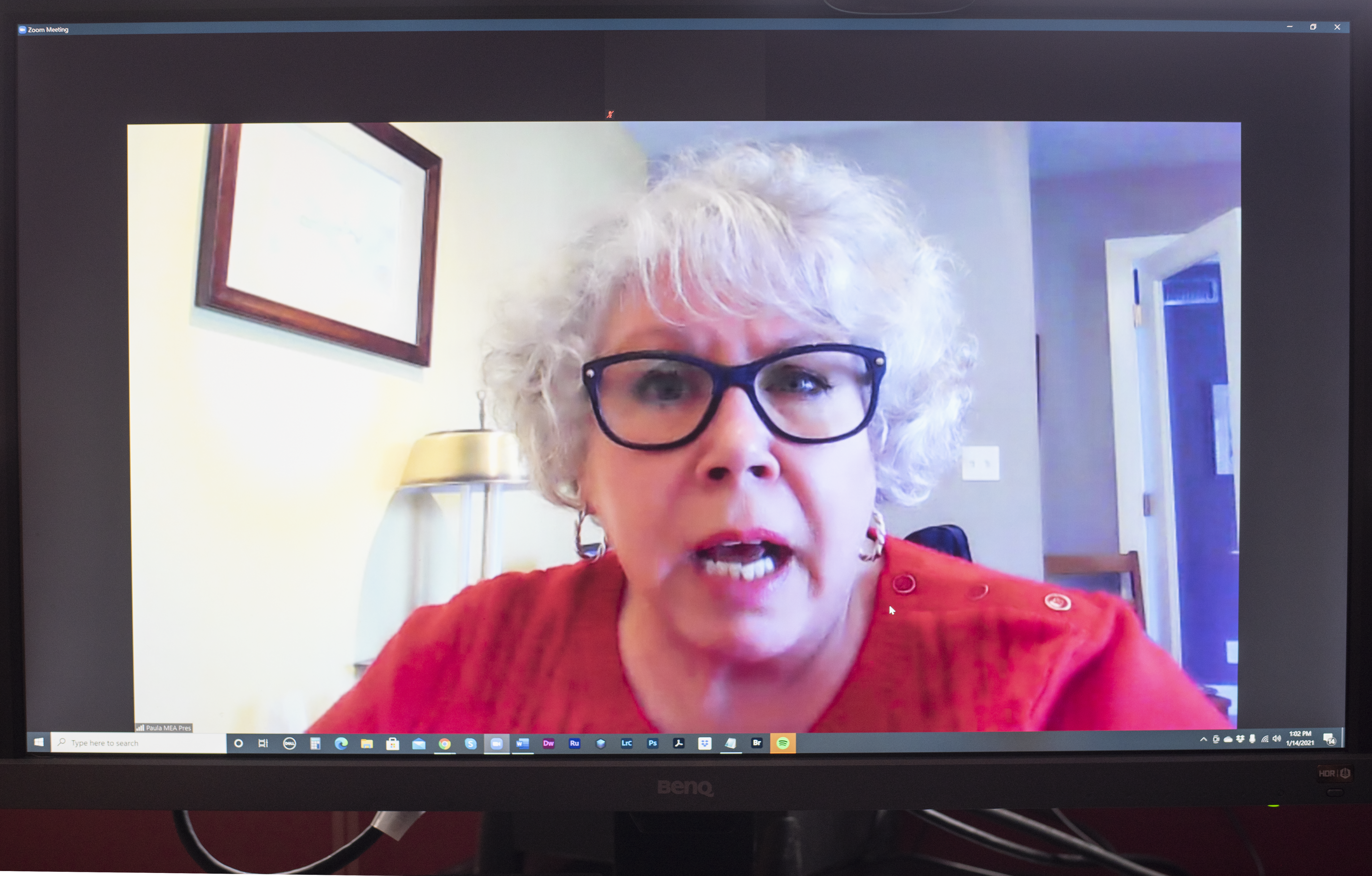COVID-19 Q&A with Paula Herbart
It’s been nearly one year since a novel coronavirus first began reshaping daily life across the globe and MEA mobilized its bargaining, advocacy, legal and communications resources in response. We sat down with MEA President Paula Herbart to look back at where we’ve been. Here’s an excerpt from our talk.

Last month, with school employees starting to receive vaccinations against COVID-19, Gov. Gretchen Whitmer encouraged school districts to begin planning to offer a face-to-face learning option for students by March 1 if they hadn’t before then.
What’s important for our members to keep in mind as that work continues?
Several mitigation strategies go along with vaccination, so the critical piece is to plan how to reopen safely with educators seated at that table. We’ve had school districts across the state offering some version of in-person learning since the beginning of the school year and have found some successes. We’ve also seen a broad set of challenges, not the least of which are a huge lack of substitutes and varied adherence to safety standards. We have had some school districts fined by MIOSHA [the Michigan Occupational Safety and Health Administration] for not following the state’s reopening guidelines.
It’s not just one mitigation strategy that keeps people safe, even with the vaccine. It’s four or five strategies that work like a puzzle to ensure that our students, faculty and staff can return to buildings as safely as possible to teach in a superior model, which we know is face to face.
None of that works if community transmission rates are high, though, right?
That’s the big key. It’s incumbent upon each of us—inside and outside of schools—to take all these safety measures seriously. It won’t do us any good to have everybody in the schools mask up if people in the community are holding large gatherings without masking or distancing, or if people go into the grocery store and defiantly refuse to put a mask on.
That’s why it’s so frustrating when many state and federal lawmakers continue to refuse to advocate for wearing masks—or to even wear masks themselves.
The Michigan Legislature should have made masks mandatory in public, right from the start, period. And yet, we still have legislators who walk into that Capitol building and refuse to mask. That is professional malpractice. The fact that an individual in a position of power refuses to do the one thing we know is the best strategy against spreading this disease is repugnant to me. You cannot insist that somebody else risk their life because you decided you don’t care about yours. Children are watching, so adults need to start behaving like adults and do what it takes to make sure students and schools are safe.
Many educators say they are feeling unappreciated—disrespected even—because of things being said in school board meetings where parents are pushing for full-time face-to-face learning for all students. What are you hearing from members about what their lives and work look like right now?
A close friend of mine teaches middle school science. She’s up at 5:30 in the morning, and at 7:30 at night she starts planning for the next day. She’s up till past midnight. She’s literally working around the clock in order to provide for these students— meeting one-on-one to ensure those students who were absent can get caught up and following up with families. School boards and people in positions of power need to understand. It’s hard to be an educator, doubly so right now, and we don’t have the comfort of seeing the students’ faces or being able to touch their shoulder in reassurance or to give a hug to a small child when they feel frustrated. It’s so difficult, and we don’t have the coping mechanisms that we’ve had in the past. There is no escape for anyone, and it’s beyond stressful. Educators are doing amazing work to improve virtual learning and, in the end, want to be face to face. But we have to be safe. We need to be involved in planning; we need to be listened to; and we need adequate safety equipment, protocols, and procedures.
How would you sum up the union’s role in helping?
Throughout the entire pandemic, the MEA and our locals have been at the table to ensure educators were a part of decision-making. If we knew that wasn’t happening, we fought to insist on it. We’ve developed strategies for those locals to have members’ voices heard—to act on grievances, to take collective action, to ensure members’ fears and concerns don’t go unanswered. In many cases where we’ve pushed, we’ve seen real change— maybe not 100 percent what everyone wanted, but significant movement. It’s no small thing to go from full-time face-to-face to virtual learning for six weeks to allow for the procurement of more PPE [personal protective equipment] or until case numbers go down. Some of our leaders’ and staffs’ work to keep members out of harm’s way happens behind the scenes and doesn’t get a lot of airplay. But rest assured, had the union not been involved since the beginning, things would look a lot more dire in this state.
Going back to March, what are the top moves the union made?
Well, if I could go back to the first thing we did that has made a difference, it’s that we got Governor Whitmer and Attorney General Nessel and Secretary of State Benson elected. That is a huge thing. If Bill Schuette had been our governor, I believe we would have been pushed into reopening face-to-face without a focus on safety protocols. Instead, we’ve been involved in planning.
Last spring we worked with the Michigan Department of Education to make sure evaluations were postponed and standardized tests were waived.
We fought for our sisters and brothers who are support staff, regardless of whether they were working directly with students or not, to receive their pay for March until the end of the school year. We got that.
And remember the hazard pay money that passed the Legislature? The initial Republican proposals left out support staff, we pushed and pushed to get it expanded to include others—and we did.
It was telling stories at the state level to highlight the work educators were doing, and through the summer being the voice for educators on mask wearing. We kept hammering that message until masks became mandatory for all students, not just middle school and up. And it was pushing back against districts that were nonsensically requiring people to be in school buildings to teach students remotely.
Those are a just few examples of what we’ve been able to do—and in each of those areas, we fought to do more. We’re continuing to advocate in this school year for the suspension of evaluations and standardized testing. In fact, we’re pressing for bubble test scores to weigh less heavily in educator evaluations from now until forever, because those changes have harmed the profession. That is a push our lobbyists picked up again in January as the new Legislature was seated.
So what do you say to young people coming into the profession about why it’s more important than ever to join the union?
We get the respect we’re given at the statewide level because we have the membership numbers we have. Because there are people behind those numbers, people who do the good work of the state, and we represent their interests. Because there are so many of us and because we speak with one voice, that voice is listened to in a way that no individual or small group could ever hope to accomplish. Being united in purpose means all of us over time are seeing improvements. But the minute we drop our guard, the minute we start abdicating our power or abdicating our responsibility to being a union member and being active in the union, is the minute that we start losing the battle.
What we know has worked for decades—the unionism and collective action that has helped our profession move forward—has also helped to turn around bad changes that we couldn’t stop. Nothing worthwhile is easy, and the most satisfying wins aren’t accomplished overnight. It takes all of us to get engaged and push in the same direction to make it happen, so join the union and be a part of the good fight for educators and for public education!
Read more stories from the series, “What it’s Like: COVID Vignettes”:
Karen Moore: secretary with a purpose
Karen Christian: COVID ICU survivor
Jacob Oaster: leader, teacher, innovator
Amy Quiñones: Charting New Waters
Union Presidents Lead through Unprecendented Crisis
Jill Wheeler: On Books, Kids, and ESP
Gary Mishica: His Work is Hobby, Joy, Passion
Demetrius Wilson: ‘We’ve made it work’
Shana Barnum: ‘It’s heart-wrenching’
Claudia Rodgers: Committed to her Work
Danya Stump: Building Preschool Potential
Rachel Neiwiada: Honored on National TV
Tavia Redmond: ‘Let me tell you about tired’
Gillian Lafrate: Student Teaching With a Twist (or two)
Jaycob Yang: Finding a Way in the First Year
Julie Ingison: Bus Driver Weaves Love into Job
Chris DeFraia: Sharing a Rich Resource



